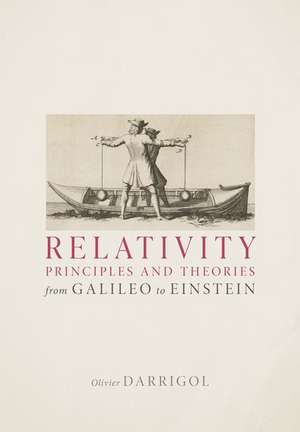Relativity Principles and Theories from Galileo to Einstein
Autor Olivier Darrigolen Limba Engleză Hardback – 22 dec 2021
Motion is always relative to some thing. Is this thing a concrete body like the earth, is it an abstract space, or is it an imagined frame? Do the laws of physics depend on the choice of reference? It there a choice for which the laws are simplest? Is this choice unique? Is there a physical cause for the choice made? These questions traverse the history of modern physics from Galileo to Einstein. The answers involved Galilean relativity, Newton's absolute space, the purely relational concepts of Descartes, Leibniz, and Mach, and many forgotten uses of relativity principles in mechanics, optics, and electrodynamics - until the relativity theories of Poincare, Einstein, Minkowksi, and Laue radically redefined space and time to satisfy universal kinds of relativity.
Accordingly, this book retraces the emergence of relativity principles in early modern mechanics, documents their constructive use in eighteenth- and nineteenth-century mechanics, optics, and electrodynamics, and gives a well-rooted account of the genesis of special and general relativity in the early twentieth century. As an exercise in long-term history, it demonstrates the connectivity of issues and approaches across several centuries, despite enormous changes in context and culture. As anaccount of the genesis of relativity theories, it brings unprecedented clarity and fullness by broadening the spectrum of resources on which the principal actors drew.
Preț: 339.51 lei
Preț vechi: 408.63 lei
-17% Nou
64.96€ • 68.01$ • 53.75£
Carte disponibilă
Livrare economică 04-10 martie
Livrare express 01-07 martie pentru 126.20 lei
Specificații
ISBN-10: 0192849530
Pagini: 496
Ilustrații: 30 illlustrations
Dimensiuni: 175 x 246 x 27 mm
Greutate: 1.09 kg
Editura: OUP OXFORD
Colecția OUP Oxford
Locul publicării:Oxford, United Kingdom
Recenzii
Students and professionals will benefit from access to this unique work by an accomplished researcher.
As an exercise in long-term history, it demonstrates the connectivity of issues and approaches across several centuries, despite enormous changes in context and culture. As an account of the genesis of relativity theories, it brings unprecedented clarity and fullness by broadening the spectrum of resources on which the principal actors drew.
This book is not only an accurate history of the physical relativity principles of motion during the last three hundred years, it is also an important book about the cognitive relativity of scientists' understanding of issues that once were challenging but which present-day physicists consider commonsense.
Truly excellent and fills an important gap in the research landscape on relativity.
Well thought out and could become the definitive work that connects the developments pertinent to relativity from the 17th century to the present.
Notă biografică
Olivier Darrigol studied physics at the École Normale Supérieure in Paris, the history and philosophy of physics at the Sorbonne and at UC-Berkeley's Office for History of Science and Technology (OHST). He is the author of several books on the history of quantum physics, electrodynamics, hydrodynamics, and optics. He is currently a member of the SPHere research team at CNRS/Paris 7, and a Research Associate at UC-Berkeley'sOHST.
